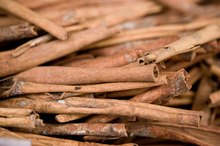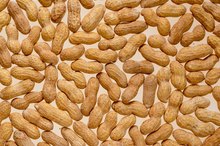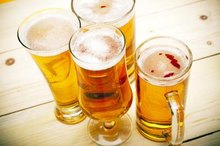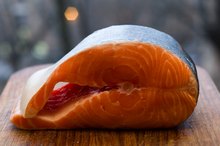Peanut Butter & Triglycerides
High levels of triglycerides in your bloodstream increase your risk for suffering a heart attack or stroke. Foods in your diet that have saturated fat, trans fat and sugar can raise your triglyceride levels. Regular commercial brand peanut butter contains some saturated fat and sugar, but you can safely include it in a diet geared to lowering your triglyceride levels.
Healthy Triglyceride Levels
Your cholesterol levels -- and heart health -- are affected by three types of lipids in your bloodstream: low-density lipoprotein cholesterol, high-density lipoprotein and triglycerides. LDL, or “bad” cholesterol, and triglycerides, a type of fat, tend to clog your arteries. HDL, or “good” cholesterol, helps pull LDL cholesterol and triglycerides out of your arteries. The goal is to keep your LDL cholesterol and triglycerides low and your HDL high. Healthy triglycerides should measure 150 mg/dl or less. In April 2011, the American Heart Association lowered its recommendation for triglycerides to 100 mg/dl or less 2. Triglyceride levels of more than 200 mg/dl put you at high risk for developing cardiovascular disease, and levels above 500 mg/dl put you at very high risk.
- Your cholesterol levels -- and heart health -- are affected by three types of lipids in your bloodstream: low-density lipoprotein cholesterol, high-density lipoprotein and triglycerides.
- HDL, or “good” cholesterol, helps pull LDL cholesterol and triglycerides out of your arteries.
Saturated Fat and Trans Fat
Honey & Cinnamon to Lower Triglycerides
Learn More
The American Heart Association says you can lower triglycerides by 50 percent through diet and exercise 2. The recommended diet includes no more than 16 grams of saturated fat and no more than 2 grams of trans fat per day. Two tablespoons of peanut butter contain about 3.4 grams of saturated fat and negligible amounts of trans fat. Although commercial brand peanut butter contains hydrogenated fat -- a source of trans fat -- the amount is undetectable, according to an Agricultural Research Service study led by Timothy H. Sanders and reported by the United States Department of Agriculture in June 2001 13.
Sugar
The American Heart Association also recommends you limit calories from foods with added sugar to 5 percent to 10 percent of your diet -- or about 100 to 200 calories a day, based on a 2,000-calorie-a-day diet. A 2-tablespoon serving of peanut butter contains only 2.95 grams of sugar, which amounts to about 12 calories. Peanut butter also contains heart-healthy unsaturated oils such as oleic acid. In the ARS study, the amount of oleic acid in peanut butter ranged from 19 percent to 27 percent of total weight.
- The American Heart Association also recommends you limit calories from foods with added sugar to 5 percent to 10 percent of your diet -- or about 100 to 200 calories a day, based on a 2,000-calorie-a-day diet.
- A 2-tablespoon serving of peanut butter contains only 2.95 grams of sugar, which amounts to about 12 calories.
Considerations
Does Whiskey Affect Your Cholesterol?
Learn More
You can include peanut butter in a triglyceride-friendly diet that also includes high-fiber foods such as whole grains, fruits and vegetables. Try eating peanut butter on multigrain bread, with slices of bananas, pears or apples, or with celery. Maintain a healthy weight and get at least 150 minutes of moderate exercise per week. If you need to lower your blood pressure, choose low-sodium varieties of peanut butter. Regular peanut butter contains about 146 milligrams of sodium per 2 tablespoons Persons with high blood pressure should limit sodium to 1,500 milligrams per day.
- You can include peanut butter in a triglyceride-friendly diet that also includes high-fiber foods such as whole grains, fruits and vegetables.
- Regular peanut butter contains about 146 milligrams of sodium per 2 tablespoons Persons with high blood pressure should limit sodium to 1,500 milligrams per day.
Related Articles
References
- United States Department of Agriculture Nutrient Database: Peanut Butter, Smooth With Salt
- American Heart Association; Diet, Lifestyle Changes Can Significantly Reduce Triglyceride; April 18 2011
- United States Department of Agriculture; No Trans Fat Found in Peanut Butter – Contrary to Popular Rumor; Judy McBride; June 12, 2001
- Guasch-Ferré M, Liu X, Malik VS, et al. Nut consumption and risk of cardiovascular disease. J Am Coll Cardiol. 2017;70(20):2519–2532. doi:10.1016/j.jacc.2017.09.035
- Bes-Rastrolio, M.; Wedick, N.; Martinez-Gonzalez, M. et al. Prospective study of nut consumption, long-term weight change, and obesity risk in women. Am J Clin Nutr. 2009 Jun;89(6):1913-9. DOI: 10.3945/ajcn.2008.27276
- Bonnefont-Rousselot, D. Resveratrol and cardiovascular diseases. Nutrients. 2016 May;8(5):250. DOI: 10.3390/nu8050250
- American Academy of Allergy, Asthma, and Immunology (AAAAI). Newly Issued Clinical Guidelines from NIAID Recommend Early Peanut Intervention, Not Avoidance. Milwaukie, Wisconsin: AAAAI; issued January 5, 2017.
Writer Bio
Kathryn Gilhuly is a wellness coach based in San Diego. She helps doctors, nurses and other professionals implement lifestyle changes that focus on a healthy diet and exercise. Gilhuly holds a Master of Science in health, nutrition and exercise from North Dakota State University.









